50-mm mortars of the Second World War: experience, problems, prospects.
As you know, then there were mortars caliber 20-mm. Here are just they shot over-mine mines, the charge of explosives in which reached 10-ti and more kilograms. And although one person could not carry it, for certain conditions it was almost an “absolute weapon”. The Stokes mortar of the caliber 76-mm (later 80-mm) and literally immediately followed him, the first two-inch 50-mm English mortar (real caliber 50,8-mm) of the model 1918 of the year, which fired fragmentation mines weighing about one kilogram. However, a year later they were decommissioned as insufficiently effective.
And here the Italians entered the world arena with their 45-mm mortar. It was called “45 / 5 model 35“ Brixia ”(sample 1935), and it can be argued that it was the most difficult and most unsuccessful mortar in all history. The impression is that the designers who created it acted “without a rudder and without winds” and tested their creative imagination on it: “Let's do it like that! And what if you try it ?! ”And they tried! The result was a weapon that weighed 15,5 kg, fired a mine weighing 460 g at a distance of 536 m. The most unsuccessful decision was to load it from the breech, for such a mortar is not at all justified. The shutter was opened using a lever that had to be moved back and forth, and at the same time another mine was fed from the 10-charging shop into the barrel.
The shot was made by a shooting device, but a gas crane served to change the range. However, all this complex "automation" led to the fact that the rate of mortar did not exceed 10 rounds per minute. True, if the gunner was well prepared, the mines during the shooting could go quite well, but they were too weak, while the weight of the mortar itself was too great! In the Italian army they were used for infantry fire support at the platoon level. All (!) Soldiers were trained to operate with him, so that in the event of the death of the calculation, the mortar continued to fire. But in Africa all this didn’t help much. The complex mechanisms of the mortar were constantly clogged with sand and failed. Well, it was suicidal to open the faucet and release a surplus of gases directly in front of you, as it raised a cloud of sand! Interestingly, for the training of work with this mortar for the Italian paramilitary youth formations, a lightweight model of the caliber 35-mm was created, firing training mines. The Germans also used this mortar and even gave it its own name - “4,5-cm Granatwerfer 176 (i)”.
In conclusion, it can be said that the Italians were probably even proud of having made such a mortar. That's just incomprehensible, didn’t they understand all its complexity and failed to do something simpler? This is truly: it is difficult to do, it is very simple, but it is very difficult to do it!
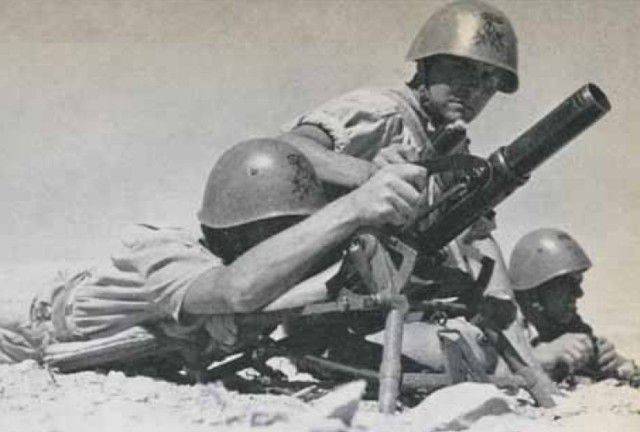
Mortar "Brixia" in the sands of the Sahara.
Then the 50-mm mortar was created in Spain, and it was here that the English didn’t hold their nerves (now return to them again), and they immediately decided to return to mortars of this caliber in order to keep up with the others. And they didn’t come up with anything better than copying a Spanish sample! Although they not only copied it, they also creatively remade it for themselves. First of all, the barrel was shortened to 530 mm. And since it is impossible to shoot a shot from such a short barrel, a shooting device was placed on it. Then put on him a sophisticated collimator sight. However, tests have shown that he does not bring great benefits, and he was rejected in favor of ... a simple white line drawn on the trunk! With one of the upgrades, they also abandoned a large base plate, replacing it with a very small metal stop, and in this form, this mortar, having a weight of only 4,65 kg, ended its participation in World War II. It is noted that the power of his mines, weighing 1,02 kg, is not so great, but the rate of fire equal to 8 rounds per minute still allowed you to create a fairly effective zone of destruction of enemy infantry. Smoke mines have shown themselves to be even more effective, so the 2,5-inch (51-mm) Mk VII mortar used in the Indian Army is still in use as a smoke mortar! That is, the development trend was as follows: the initial design was unnecessarily complex, but then it was simplified, without losing any efficiency!
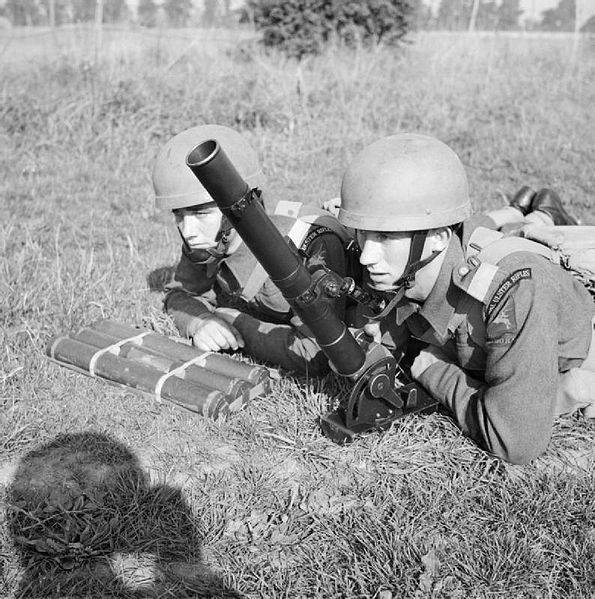
Test English 2,5-inch mortar in August 1942 year.
In the same 1938 year as the British, 50-mm company mortars were put into service in the Red Army and in Germany. A Soviet mortar of the 1938 model with a mass of 12 kg threw a mine in 850 g at a distance of 800 meters. The German 5cm leichter Granatenwerfer 36 (sample 1936 g.) Weighed 14 kg, its mine weighed 910 g, but then the firing range was 520 meters maximum. That is, like our weapons in all respects (except for the weight of a mine) exceeded the German, yes? However, alas, he also had flaws. Thus, the minimum firing range was 200 m. The mortar had an adjusting valve for the release of a part of the powder gases, which, when released, were beaten into the ground and raised a cloud of dust. The experts noted that the calibration of this very crane was incorrect, so it was impossible to get accurate shooting out of this mortar, except to shoot it “by eye”. There were other shortcomings, and they decided to eliminate all of them on the mortar of the 1940 sample of the year and ... something really was eliminated, but not all. In particular, they could not improve the reliability of the sight mount, although it would seem that it’s so difficult to make the mount stronger and more reliable! For some reason, only two fixed elevation angles in 1938 and 1940 degrees were set in the Soviet mortars of the 45 and 75 models, with the biped for some reason, and the whole further aiming was achieved, firstly, by adjusting the gas tap, and more precisely by adjusting the striker and the chamber volume. How can you not remember: "it is difficult to do - very simple, but simply - very difficult." It is believed that before the war the USSR produced no less than 24000 of such company mortars, but that the losses in them at the beginning of the war were extremely high.
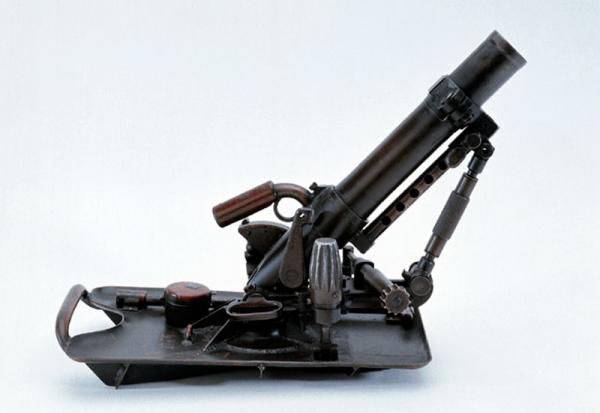
German 5cm leichter Granatenwerfer 36.
German mortar was heavier than ours on the 2 kg. But solid weight guaranteed greater stability, i.e. firing accuracy. Vertical pickup 42 - 90 degrees, and that's due to it, and then there was a change in firing range. There were no cranes on it! The mortar was equipped with a mine with such a sensitive fuse that the calculation was forbidden to shoot in the rain. The mortar was carried by the assembled handle, it was quickly installed in the position, and it was immediately possible to start accurate fire from it. The length of the barrel 465 mm was small and allowed the mortar not too rise above the ground. By the beginning of the 1939 of the year, the Wehrmacht had 5914 units of such weapons, and it was produced before the 1943 of the year.
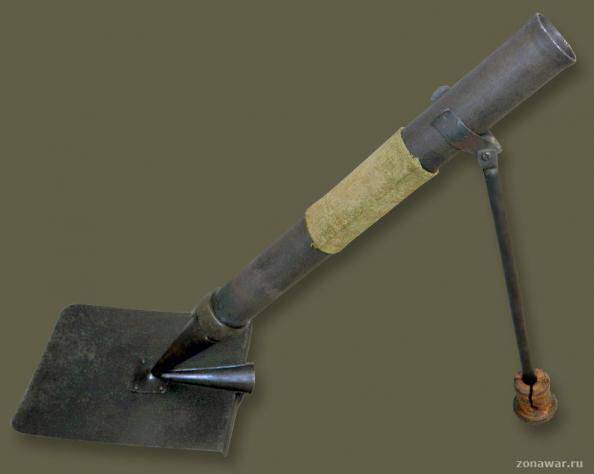
Mortar shovel.
It is impossible not to mention the infamous "mortar-shovel" caliber 37-mm, the shooting of which initially could not be effective, especially with a sufficiently deep snow cover, but which, nevertheless, adopted the Red Army. Where, how and when on trial this weapon showed its “outstanding results”, and who exactly assessed them and how then it was justified from the charges of ... it is clear what, probably, only Shirokorad knows. We, however, are important result of this adventure - the money spent, time, and ... abandoned by retreating soldiers "mortars, shovels." Only in 1941, the 50-mm rotary mortar of the model 1941 of the designer Shamarin, or just RM-41, was adopted for service by the Red Army. He got a comfortable stove with a carrying handle and could quickly open fire. Those. the problem was finally solved, only by this time all the heavy 50-mm and our and German are already morally obsolete. No wonder they were abandoned in 1943 year!
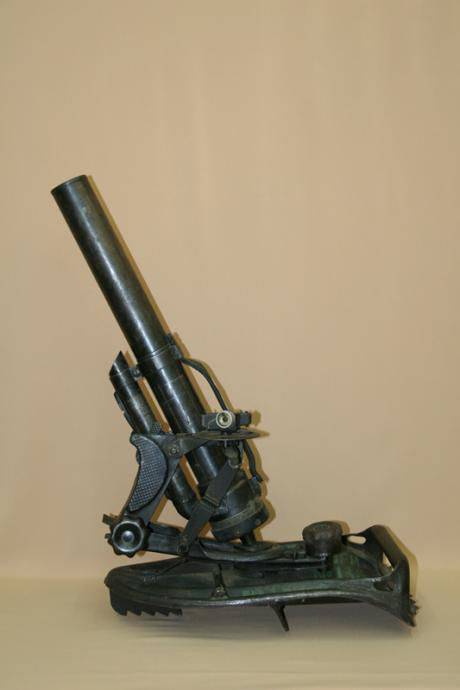
Shamarine's mortar.
The Japanese attended to such a device back in the 1921 year and called it "10 Type" in their chronology. The name 50-mm caliber "Type 10" was a smooth-bore mortar, which the Japanese themselves called a grenade launcher, since it could also be fired from with a grenade. The range control device was very simple, but original. Through the barrel passed the tube firing mechanism with a thread on the outer surface. And on the mortar case there was a grooved coupling connected to the gear. The clutch had to be rotated and the barrel either moved towards it, or, on the contrary, it was unscrewed. The length of the charging chamber, respectively, either decreased or increased. And that's it! No more difficulty!
The firing mechanism itself was also very simple - a spring-loaded striker on a long rod and a trigger lever. The graduation of ranges was also applied to this rod and therefore was clearly visible. Well, for the production of a shot, it was necessary only to lower the pre-cocked percussion mechanism. With a small weight (2,6kg) and a barrel length of just 240 mm, the 10 Type grenade launcher made it possible to shoot a universal grenade weighing 530 g to a distance of 175 m. The charge of grenades with a corrugated body contained TNNX g of TNT. The sight was missing, but the fairly significant power of the ammunition of this weapon in the jungle turned it into an unpleasant surprise for the enemy. It is interesting that the same grenade could have been thrown by hand, and its device was very simple: a cylindrical corrugated body, a fuse in the head, and a propelling charge in the tail. Moreover, the latter was located in a steel cylinder of a smaller diameter compared to the grenade body. The charge inside was in a container of thin copper sheet, which ensured water resistance. Holes for the exit of gases were in the end face of the cylinder and along its perimeter. When the capsule, which was located behind the end hole, was pricked, the propellant composition ignited, the gases broke through the walls of the copper cylinder, flowed into the barrel, and threw a grenade out of it. Well, they threw it like this: they pulled out the safety ring and hit the capsule on something solid. After this explosion followed in seven seconds!
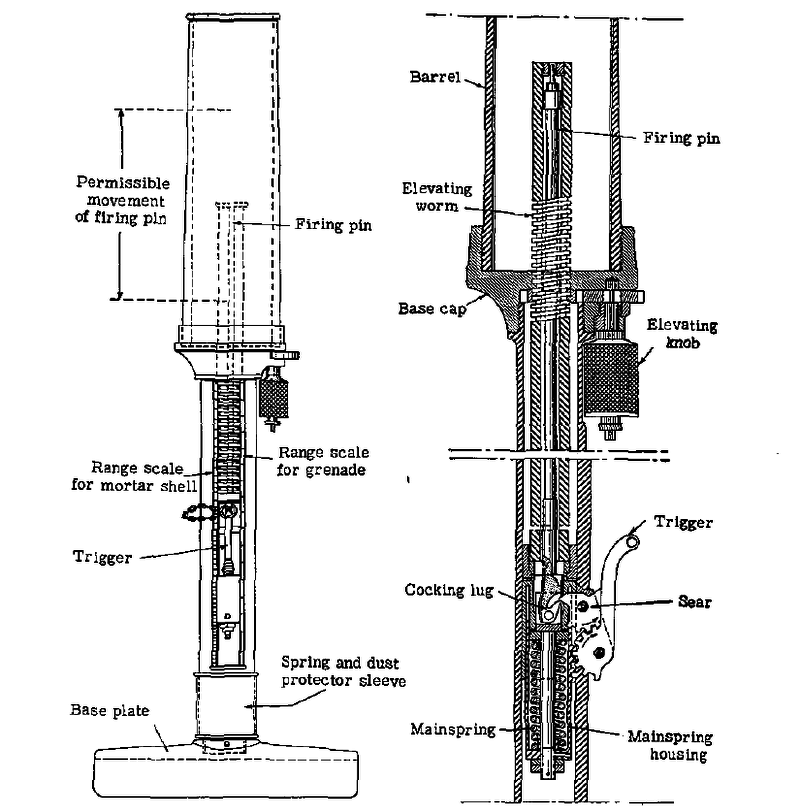
The device mortar "Type 10" - as you can see, a very rational and well thought out design.
In 1929, the mortar grenade launcher was modernized and called the "Type 89". The weight increased from 2,6 to 4,7 kg, the barrel length increased slightly from 240 to 248 mm, as did the firing range of old ammunition: from 175 to 190 m. But the barrel became rifled and under it was made new ammunition - mine grenade. Type 89 ”, with which almost fourfold (to 650 - 670 m) increased the range of fire, and the lethal force significantly increased. True, the old universal grenades were massively used, as before, since they were released a lot, but the new ones were widely used.
Well, and, of course, how the Japanese have achieved this, is also worth telling, because this is a good example of unconventional engineering thinking. The fact is that in all the then 50-mm mortars, mines of the traditional, drop-shaped form were used, and a large explosive charge was not placed in them. The Japanese made the case cylindrical, with a screwed bottom and a hemispherical head, into which the fuse was also screwed. A cylindrical part for a propellant powder was screwed onto the bottom of the mine shell. In its bottom there were nine holes: one in the middle for the striker and eight around for exhausting powder gases. The vertical wall of the cylinder was made of copper tape - that's all! Upon ignition of the powder charge, the soft copper tape expanded and pressed into the grooves, thus completely eliminating (due to its width!), The breakthrough of gases to the outside! We add that "Type 89" could also understand into three parts, which carried the three soldiers. Each platoon of Japanese infantry had 3-4 such mortar-grenade launchers, partly equaling its chances in battles with the armies of the United Nations.
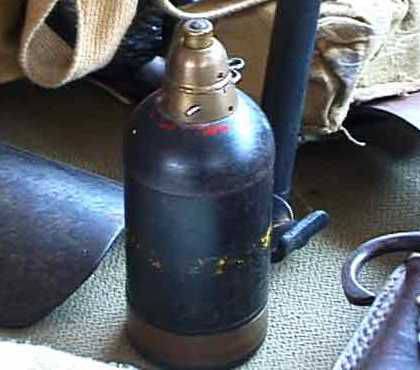
Mina to the mortar "Type 89".
There is a bike that the Americans called it a “knee-deep mortar” (incorrect translation or particular mentality) and believed that it was necessary to shoot it by resting the base plate on the knee! There are photographs confirming that the Americans shot at him like this, however, it was impossible to say many or few instances of such shooting, except that each of them ended in injury for the shooter. Well, injuries usually quickly teach that you can't do that!
Interestingly, the French also released a light mortar "50mm Mle1937" in 1939 year, and he even managed to make war, but the main light mortar of the French army was still not he, but 60-mm mortar "60mm Mle1935" designed by Edgar Brandt. His design was the simplest, which can only be: pipe, stove, bipedal. Shot a mortar pinned. At the same time its weight was 19,7 kg, the angle of elevation from + 45 to + 83 degrees. The weight of the mines is 1,33 kg, the bursting charge is 160 g, and the rate of fire reached 20-25 rounds per minute. The minimum firing range was 100 m, and the maximum - 1000 m. In the Wehrmacht, this mortar was also used and was called 6 cm Gr.W.225 (f) (Granatenwerfer 225 (f)). In addition, the release of this mortar was established by the Chinese and ... the Americans, who organized its release under the index М2. In 1938, the Americans bought eight mortars from the Brand company, tested it and designated it as M1, but it soon became the M2 from them. For paratroopers paratroopers a lightweight version of the M19 was designed, similar to the English 2,5-inch, and also devoid of two-legs and with a primitive emphasis. It was a very simple 60,5-mm mortar, which had a length of 726 mm and a weight of 9 kg. The shooting range of American mortars with a weight of 1,36 mines kg ranged from 68 to 750 m.
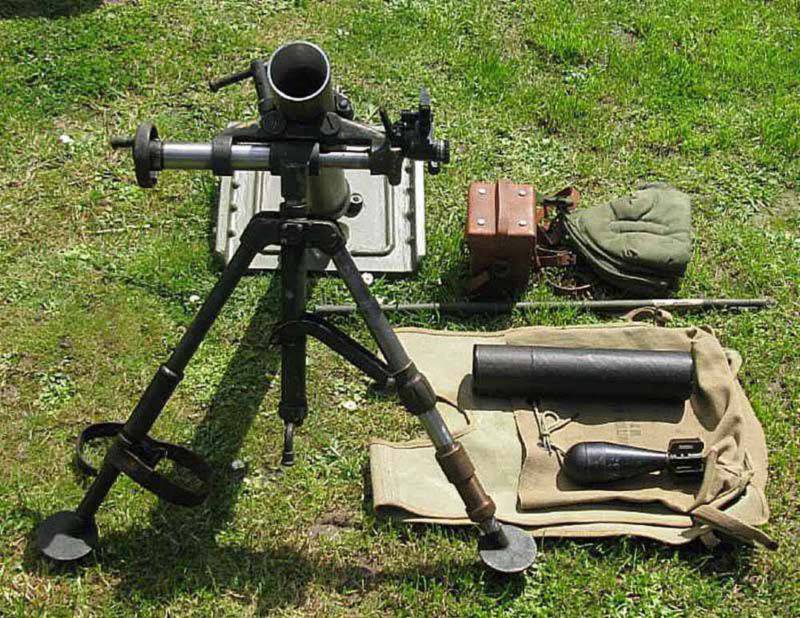
American mortar M2 with a set of accessories.
That is, there can be only one conclusion - and it is confirmed by the experience of the Second World War and subsequent local conflicts: 50-mm mortars are not as effective as 60-mm in terms of the weight-effectiveness and cost-effectiveness criteria. It got to the point that in the USA the 81-mm mortar М29 was considered too heavy and was replaced with the 60-mm mortar М224, shooting a non-80 mine with a weight of 1,6 kg for a range 4200 m (normal range 3500 m). The 51-mm mortar was in service with the army of Great Britain, and you can even shoot at 50 m, and the maximum range is equal to 800 m. The weight of the high-explosive fragmentation mine 920 g, the lighting and smoke mines - 800 g. analogue of the period of the Second World War. It is interesting that one of the tasks of mortars with these mortars is to highlight targets for calculating the Milan “ATGM”. The standard satchel includes five mines plus a mortar (8,28 kg), and the British army carries all this alone! 60-mm mortar with a long barrel released in South Africa and this is a South African's own development. They believe that the power of the long mine, which he shoots, is comparable to the power of 81 / 82-mm mortars of conventional construction. The firing range is also about the same and ... why then do more if you can do less?
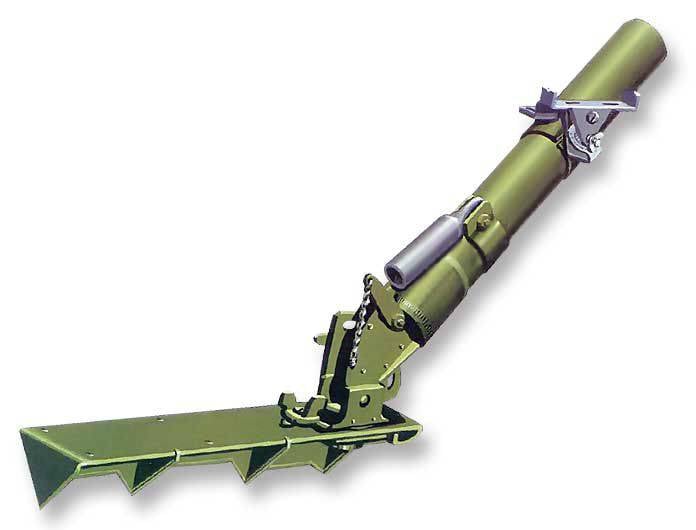
English 2,5-inch mortar before upgrading.
The most “large-caliber” mortar among 50 / 60-mm is the Swedish “Lyran” mortar. His caliber is 71-mm, but he only shoots lighting mines. Externally, the mortar in the transport position consists of two plastic cylinders with longitudinal grooves, interconnected. In one - the trunk and two lighting mines, in the other - four mines. To bring it into action, you need to screw the barrel into the slot on the container, sit on the container, tilt the barrel by 47 degrees and ... shoot! You can fire at a distance of 400 and 800 m, while the diameter of the illuminated spot on the ground when the mine is at a height of 160 m is about 630 m in diameter! The Israeli mortar “Soltam” firing range is equal to 2250 m, with the weight of the mortar itself with the supporting biped and sight - 14,3 kg, that is, it weighs less than the American M224. Mina weighs 1590 g. Well, the French 60-mm “Hotchkis-Brand” weighs 14,8 kg, has a mine weighing 1,65 kg, but its firing range is less than that of the Israeli - 2000 m.
And finally, the last. What bribes small caliber mortars? Convenience of transportation, but it makes sense to use them only where the enemy has only small arms. But in this case, it is not at all difficult to create a very lightweight mortar that will fire mines with a caliber from 50 / 60 to 81 / 82 mm and more. Its design is very simple: a base plate, a screw rod on it, at the base of which there is a very short interchangeable barrel with a shooting device or no “nothing” at all, for firing. The sight can be portable. Jet mines are put on this rod, for which a tube of the corresponding diameter passes through them, including the fuse. At the end of the mine there is an expelling charge included in the removable barrel. When fired, the expelling charge throws a mine into the air, and then a rocket engine accelerates it. Shooting from such a mortar can be carried out by the appropriate mines of any caliber and give a whole bunch of trajectories. It is impossible to say how such a system will be truly effective. But theoretically ... why not?
Information